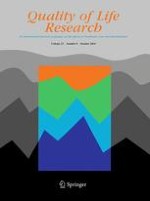01-10-2014
Factorial structural analysis of the Spanish version of WHOQOL-BREF: an exploratory structural equation model study
Gepubliceerd in: Quality of Life Research | Uitgave 8/2014
Log in om toegang te krijgenAbstract
Purpose
The purpose of this study was to analyze the factor structure of the abbreviated Spanish version of the World Health Organization Quality of Life (WHOQOL-BREF; WHOQOL Group in Psychol Med 28(3): 551–558, 1998b) questionnaire in a sample of individuals from several Spanish-speaking countries.
Method
The data were based on a sample of 1,972 undergraduates from nine Spanish-speaking countries. Within the framework of a somewhat wider research protocol, they were administered the WHOQOL-BREF.
Results
The data were initially analyzed using a confirmatory factor analysis, which yielded a poor fit to the four-factor theoretical model. Based on these results, the best solution was estimated assuming structural invariance across countries. The data showed a four-factor structure that differed slightly from the model proposed. This four-factor model was subsequently analyzed using exploratory structural equation modeling (ESEM; Asparouhov and Muthén in Struct Equ Model 16(3): 397–438, 2009) to obtain the invariant structure across countries and an estimation of the relation between the four latent factors. The results obtained allowed us to establish that the factor structure of WHOQOL-BREF maintains the four-factor solution hypothesized for a Spanish-speaking population, although the solution has a different and more complex configuration than the original one with a clear tendency toward non-orthogonality of the latent factors.
Conclusions
As has been suggested by some studies on the application of ESEM, it is reasonable to think that the ESEM approximation is a useful approach for conducting the factor analysis of instruments measuring complex psychological phenomena.
